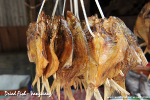This Temple consists of the well-preserved, richly coloured paintings inside. These are thought to date from the temple’s original construction in 1113, when Kyanzittha’s son Rajakumar built it following his father’s death. In Indian style, the monument consists of a large vestibule attached to a smaller antechamber.
The fine stuccowork on its exterior walls is in particularly good condition. Perforated, Pyu-style windows mean you will need a powerful torch to see the ceiling paintings clearly. If it is locked during off-season, ask in the village for the keyholder.
This durian-shaped stupaed temple was modeled after Bodh Gaya in India. It has also murals depicting scenes from the Jataka tales. But the best feature in this temple is the rooftop view of the surrounding area even if it's not as high and acrophobic as those in its category.
Architecturally it belonged to the early period of Bagan. Being a cave pagoda of early time, it allows but little light into it. So it is gloomy inside. Mural paintings on its walls are little affected by light. The base is in the shape of Kalatha pot. The roof is curvilinear and the dormer window lets in the light to fall directly upon the big images. Such are the peculiar architectural features of early period of Bagan.
Note:
There are two temples in Bagan called Gubyaukgyi - make sure you get the right one. This one, with fantastic murals inside is near Myinkaba village. Beside the temple is the golden spire of Myazedi Pagoda and in the grounds lies Myanmar's equivalent of the Rosetta Stone. It is a stone column, with different ancient languages on its four sides, Mon, Pali, Pyu & Burmese.
The whole temple is dark for conservation purpose so you need a torch to view inside.
Open daily and not have opening or closing time. You can visit at any time but should be in day time as it is quite dark after sunset.
You are required to wear long trousers and walk on barefoot inside the temple.
30 minutes are sufficient for your visiting time.
Address:
Location: This Pagoda stands close to the western side of the Mya Zedi Pagoda near Myin Kaba village.
Entrance fee: No
Highlights:
The Myinkaba pagoda shares its name with a village and a stream. The Myinkaba is simple in form, with a dome and a final, which foreshadow Anawrahta's later work, the Shwesandaw. But the great difference is in the terraces. While those of the Shwesandaw provide a lofty, pyramidal base, those of the Myinkaba are low and circular, creating quite a different effect.
{mainvote}






